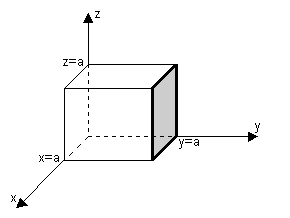Carnegie Mellon University
Department
of Electrical and Computer Engineering
18-200
Fall 2000
Mathematical
Foundations of Electrical Engineering
Problem
Set 9 (last one!)
Issued: Tuesday, December 5
Due: Tuesday, December 12 by 4:30 PM (absolute deadline) in HH B205
Problem 1: Two vectors, A and B are given by:
A = 3ax
+ 6ay 2az
B = 2ax
+ 5ay 3az
a) Find the dot product
A · B
b) Find the angle a between A
and B
c) Find the cross product A x B
d) Show that the magnitude of the cross product you
found in part c) satisfies:
|A x B|
= |A| |B| sin(a)
Problem 2: A scalar field, U(x, y, z) is given in rectangular coordinates by:

Where
a, b, and c, are known constant distances.
a) Find the vector field that is given by:

b) Calculate the line integral:

For the path
shown in the figure below. The path
starts at point (a,b,c) and follows a
straight line back to point (a,0,c),
then follows a straight line back to point (0,0,c), then follows a straight
line down to point (0,0,0).

c) Show that your result from part b) is
identical to the difference between the value of the field U at the end point
of the line integral and the value of U at the beginning point of the line
integral, i.e., show that:

Problem 3:
A vector function of space, F(x,y,z) is given by:

Where
a is a known constant distance.
a) Find the scalar function of space that is
defined by:
![]()
b) Calculate the
volume integral:
![]()
For the volume
shown in the figure below. The volume
is a cube with faces at x=0, x=a, y=0, y=a, z=0, and z=a.

c)Evaluate:
![]()
i.e., the
component of F in the direction of
the outward normal (the subscript n denotes normal) on each of the six faces of the cube (top, bottom, left, right, front,
and back). Show that your result from
part b) is identical to the total outward flux of F through the surface of the cube, i.e., show that:
![]()
Problem 4:
For the same vector function F
of space that is given in problem 3:
a) Find the vector function of space that is
defined by:

b) Consider the open surface shown in the
figure on the next page. The surface is
a square in the plane y=a, with edges x=0, x=a, z=0, and z=a. Evaluate:
![]()
i.e. the
component of the curl F in the direction
of the normal pointing out of the square surface in the positive y
direction. Then, over the square,
calculate this surface integral:
![]()

c)

Calculate the line integral:
in the
counter-clockwise direction for the closed contour that consists of the edges
bound by the open square surface as viewed from the front. Show that your result from part b) is
identical to the total circulation of F
around the closed contour that bounds the open surface, i.e., show that:
![]()